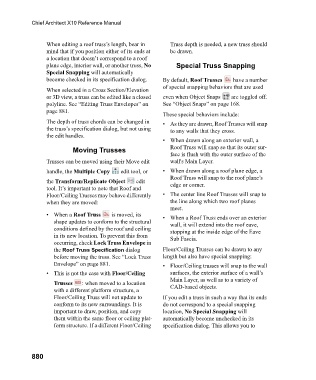Page 880 - Chief Architect Reference Manual
P. 880
Chief Architect X10 Reference Manual
When editing a roof truss’s length, bear in Truss depth is needed, a new truss should
mind that if you position either of its ends at be drawn.
a location that doesn’t correspond to a roof
plane edge, interior wall, or another truss, No Special Truss Snapping
Special Snapping will automatically
become checked in its specification dialog. By default, Roof Trusses have a number
of special snapping behaviors that are used
When selected in a Cross Section/Elevation
or 3D view, a truss can be edited like a closed even when Object Snaps are toggled off.
polyline. See “Editing Truss Envelopes” on See “Object Snaps” on page 168.
page 881.
These special behaviors include:
The depth of truss chords can be changed in • As they are drawn, Roof Trusses will snap
the truss’s specification dialog, but not using to any walls that they cross.
the edit handles.
• When drawn along an exterior wall, a
Moving Trusses Roof Truss will snap so that its outer sur-
face is flush with the outer surface of the
Trusses can be moved using their Move edit wall's Main Layer.
handle, the Multiple Copy edit tool, or • When drawn along a roof plane edge, a
Roof Truss will snap to the roof plane’s
the Transform/Replicate Object edit edge or corner.
tool. It’s important to note that Roof and
Floor/Ceiling Trusses may behave differently • The center line Roof Trusses will snap to
when they are moved: the line along which two roof planes
meet.
• When a Roof Truss is moved, its • When a Roof Truss ends over an exterior
shape updates to conform to the structural wall, it will extend into the roof eave,
conditions defined by the roof and ceiling stopping at the inside edge of the Eave
in its new location. To prevent this from Sub Fascia.
occurring, check Lock Truss Envelope in
the Roof Truss Specification dialog Floor/Ceiling Trusses can be drawn to any
before moving the truss. See “Lock Truss length but also have special snapping:
Envelope” on page 881. • Floor/Ceiling trusses will snap to the wall
• This is not the case with Floor/Ceiling surfaces, the exterior surface of a wall’s
Main Layer, as well as to a variety of
Trusses : when moved to a location CAD-based objects.
with a different platform structure, a
Floor/Ceiling Truss will not update to If you edit a truss in such a way that its ends
conform to its new surroundings. It is do not correspond to a special snapping
important to draw, position, and copy location, No Special Snapping will
them within the same floor or ceiling plat- automatically become unchecked in its
form structure. If a different Floor/Ceiling specification dialog. This allows you to
880

